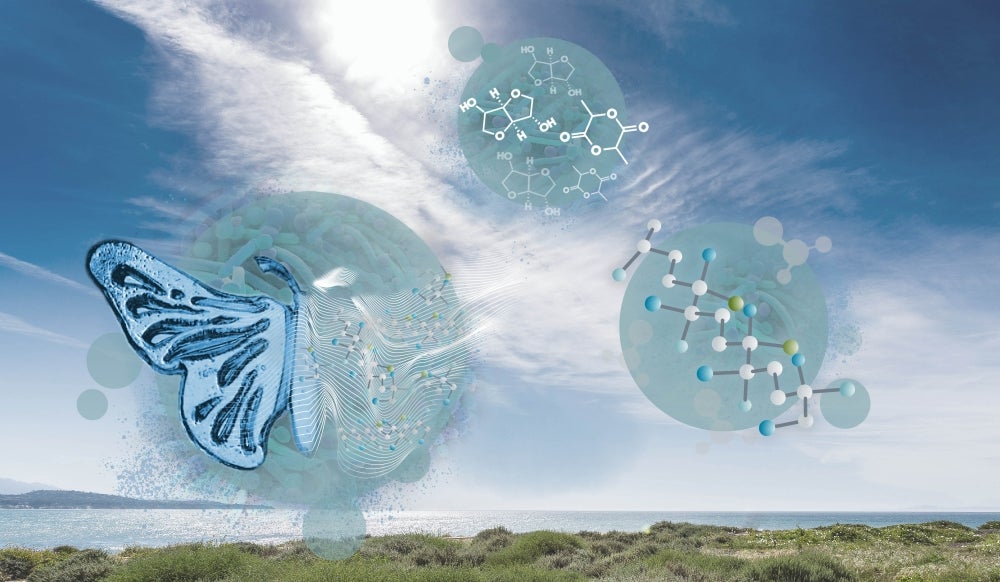
Push for Bio-based Polymers



Synthetic polymers — think plastic and its chemical cousins — are among the foundations of modern life. The ubiquity of such petroleum-based materials has everything to do with their combination of strength, flexibility and chemical inertness, the last being a characteristic that also makes them durable. Given the environmental impact of plastics and the fact that petroleum deposits are finite, one grand challenge is to develop new sustainable bio-based, high-performance alternatives to petroleum-based polymers. Harnessing nature to create these materials will be an enormous undertaking, requiring a dramatic change in how polymers are made.
To support such an effort, the National Science Foundation (NSF) has named UC Santa Barbara and UCLA joint partners in the BioPolymers, Automated Cellular Infrastructure, Flow, and Integrated Chemistry: Materials Innovation Platform (BioPACIFIC MIP). The five-year, $23.7 million collaboration is part of the NSF Materials Innovation Platforms (MIP) Program and has a scientific methodology reflecting the broad goals of the Materials Genome Initiative, which aims to develop new materials “twice as fast at a fraction of the cost.” BioPACIFIC MIP is one of two MIPs awarded this year, the second being led by Virginia Tech and the University of Georgia (GlycoMIP).
“We are extremely honored and pleased to have been named the lead institution in this NSF Materials Innovation Platform grant to develop novel soft materials,” said UC Santa Barbara Chancellor Henry T. Yang. “This exciting project recognizes and leverages several complementary, overlapping areas of expertise at UC Santa Barbara and UCLA, and significantly expands our existing longtime partnership established through our respective California Nanosystems Institutes. This new MIP project holds great promise in terms of addressing the grand challenge of discovering high-performing polymeric replacements for petroleum-based materials. I congratulate Director and Principal Investigator Javier Read de Alaniz, Co-PI Craig Hawker, and all of our participating colleagues, both on our campus and at UCLA, on this very proud moment.”
“This new MIP grant is a major milestone for our campus,” said Rod Alferness, dean of the UCSB College of Engineering. “It recognizes and builds on our strength in collaborative materials research and will enable UCSB, working with UCLA, to become an international hub for the development of new high-performance bio-based polymers that may one day favorably impact life around the globe.”
“This new opportunity builds on UCSB's strengths in materials science, which is at the interface between engineering disciplines and the natural sciences,” said Pierre Wiltzius, executive dean of the College of Letters & Science. “Together with our partners at UCLA and other users of the new tools, it will increase our footprint and knowledge in the important area of biopolymers, and in general materials relevant to biology and medicine. I am looking forward to seeing great, impactful discoveries emerge.”
“NSF is excited to support this new MIP focusing on the convergence of materials research and biology on two University of California campuses,” said Linda Sapochak, director of the NSF Division of Materials Research. “The BioPACIFIC MIP is designed to advance fundamental science toward sustainable material development, which is important for society.”
“The MIP uses a new modality of research and education/training inspired by the Materials Genome Initiative, creates a scientific ecosystem that shares knowledge, and will welcome users nationwide when it is fully operational,” said Charles Ying, NSF program director overseeing all MIPs funded by NSF.
The BioPACIFIC MIP leverages the facilities, expertise and experience of UCSB and UCLA, partners since 2000 in the California NanoSystems Institute (CNSI), which has headquarters at both campuses. It will include faculty and affiliates — 13 from UCSB and seven from UCLA, supported by seven scientific staff. BioPACIFIC MIP will impact a large number of students and researchers at both campuses and across the country in the fields of materials science, biology, chemistry and engineering. This next generation of researchers will share tools, samples, data, software and know-how for the acceleration and collective advancement of science and technology, with a focus on societal impact.
BioPACIFIC MIP is dedicated to identifying microorganisms that can be used as biological “factories” to generate the building blocks of bio-based plastics with superior properties to existing petroleum-based polymeric materials. It is envisioned as a closed-loop scientific system comprising every aspect of bio-based polymeric material development: design and discovery, building, testing and learning, with built-in feedback loops. Researchers will be welcomed from around the nation to develop, characterize and engineer new materials based on merging synthetic biology with material synthesis.
“Our goal is to be the bridge between fundamental and applied research, driving collaboration with industry and establishing Southern California as an economic driver for biomaterials research and innovation,” said UCSB materials professor Hawker, director of the CNSI and co-PI of BioPACIFIC MIP.
“The CNSIs at UCLA and UCSB were established [in 2000] as two nodes of the same entity,” said UCLA professor, CNSI Associate Director, and BioPACIFIC MIP Co-director Heather Maynard. “I see this as a perfect partnership, because we have complementary characterization tools and complementary expertise, and when we put them together, we can make a user facility that will be unprecedented in the science it will enable and the services it will provide.”
Experts in biosynthesis will markedly change how yeast, fungi and bacteria use their biological factories to generate building blocks, and will work closely with experts who specialize in cutting-edge polymerization technology, material characterization and polymer physics, and simulation. Their collective know-how will be coupled with an automated, high-throughput living bioreactor platform and robotic automation to rapidly prepare libraries of bio-based polymer materials. Integration of these platforms with computer modeling and machine learning, as well as user access to a robust facility infrastructure at UCSB and UCLA, both of which house state-of-the-art fabrication, characterization and screening tools, will further the process of optimizing these plastics derived from living organisms.
“We aim for BioPACIFIC to provide users from an extensive array of academic and industry partners with the tools and technology guidance needed to make new breakthroughs in the area of biomaterial synthesis, even if they themselves do not have the necessary expertise,” said Tal Margalith, executive director of the UCSB operation.
“Unlike many of our collaborative grants, which solely support on-campus efforts, BioPACIFIC will focus on building enabling tools and knowledge bases to bolster the biomaterials community across the nation and the world,” said Megan Valentine, a UCSB mechanical engineering professor who leads a group within BioPACIFIC focused on characterization and structure-property relationship determination.
“Nature has an expansive range of functional building blocks, and we now know it’s possible to synthesize them into better macro-materials, like polymers,” said Read de Alaniz, a UCSB professor of chemistry and BioPACIFIC MIP co-PI, who also associate director of the CNSI at UCSB. “We will be extracting blocks from nature that you can’t access in any other way and then using synthetic routes to combine them into materials that have properties that don’t currently exist.”
Organization
The BioPACIFIC MIP will serve as an innovation collaborative broken into four sections — In-House Research, External Users, Education, and Knowledge Sharing — while the scientific mission will be organized into four interconnected elements: Synthesis Biology and Living Bioreactors, Automated Synthesis/Materials, Hierarchical Computational Tools and Characterization/Structure-Property Relationship Determination.
Training the Next-generation Workforce
Another key component of the MIP is to prepare the next generation of scientists and engineers in interdisciplinary biomaterials discovery and high-throughput experimentation. A focus on outreach and fellowships will bring graduate students and postdoctoral scholars into BioPACIFIC MIP facilities to receive training and help drive investigations.
The project’s organizers will proactively engage budding researchers who represent the diversity of California. They plan to assemble a cohort of fellows that is at least half women and underrepresented minorities. Fellows will have access to special educational and mentorship opportunities, including a weeklong “summer school” led by experts from industry, academia and national laboratories.
“People have been wanting to move toward sustainable, bio-based polymer materials, but it’s really challenging to move away from petroleum-based ones, which we already know how to engineer into high-performance materials,” said Read de Alaniz. “The Holy Grail question is how do we engineer high-performance bio-based materials? That hasn’t been identified yet. That is our goal.”
For more information, news, and updates on the BioPACIFIC MIP, please visit biopacificmip.org.



